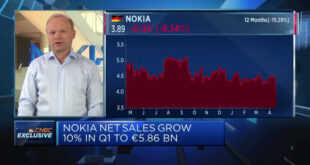
Daniel Roland | AFP | Getty Images
Daniele Nouy, Chair of the Supervisory Board of the Single Supervisory Mechanism, SSM, of the European Central Bank, ECB.
Results of the stress test of Europe’s bigger banks released Friday revealed that all of the financial institutions in the EU wide examination passed the European Central Bank’s “adverse scenario”.
The stress tests were carried out by the European Banking Authority (EBA) and the Single Supervisory Mechanism (SSM) to gauge the health of the European banking system. The EBA said in findings published on their website that all 48 banks beat the common tier ratio of 5.5 percent under adverse stress.
British bank Barclays ranked lowest in the test, scoring a common tier ratio of just 6.37 percent in the adverse scenario. Fellow U.K. bank Lloyds also performed poorly with a score of 6.8 percent. Commenting after the results, the Bank Of England said the results showed that U.K. banks could absorb the effect of the EBA’s worst scenario.
Europe’s biggest bank, Deutsche Bank, performed better than some forecasters had predicted, registering a core tier of 8.14 percent, again in an adverse scenario.
EBA said under their adverse scenario, the capital depletion across the banks at the end of 2020 was 236 billion euros ($268 billion) and 226 billion euros on a “transitional and fully loaded basis respectively.”
The European Central Bank (ECB) added that the EBA test showed that banks in Europe were now “more resilient to financial shocks.”
Italian banks were also under scrutiny but managed to record satisfactory scores according to banking regulators. Unicredit, Italy’s largest lender, scored a common tier ratio of 9.34 while UBI Banca scored 7.42 percent. The lowest score among Italian banks was for Banco BPM which registered 6.67 percent.
The assessment was carried out by placing the bank’s end of 2017 balance sheet figures and seeing how they would stand up to the strain of what the EBA describes as “adverse market developments.”
Theoretical markets shocks such as a disorderly Brexit or sudden sell-off in property were used as scenarios to examine the bank’s balance sheets. Although there was no pass or fail mark given, the key metric being used is a banks’ core tier ratio.
Tier 1 capital ratio is the ratio of a bank’s core equity capital to its total risk-weighted assets. More simply, it’s the level of reserve funding that a bank can call on to mitigate against sudden shocks or losses.
In its tests, the banks are benchmarked against a core tier ratio — 8% in the baseline scenario and 5.5% in the adverse scenario. Any figure near to, or below 5.5% is likely to give investors cause for concern.
Leading up to the results, banks in Italy were in focus, due to their high level of non-performing loans (NPLs). The EBA said in an earlier report that the ratio of NPLs in Italy was 9.7 percent during the second quarter, almost three times higher than the European average.
 EU News Digest Latest News & Updates
EU News Digest Latest News & Updates


